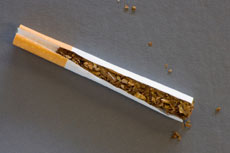What Really is in a Cigarette that Causes Conern?
Lots of talk about how harmful contents of cigarettes are without explaining what is in them. Here’s a quick rundown of common elements in a cigarette.
Cigarettes are generally composed of filters, tobacco, additives and the wrappers that hold it all together.
It might surprise you to know that cigarettes contain more than 4,000 different chemicals. Forty-three of the chemicals are known to or suspected of causing cancer – while another 400 are composed of other kinds of harmful toxins.
These chemicals are deliberately added to cigarettes by the companies that manufacture them.
Disclosures obtained or released to the public show many of these chemicals cause addiction to nicotine and enable the body to tolerate the toxins that enter when cigarette smoke is breathed into the lungs.
The most common of the chemicals that make up cigarettes include carbon monoxide, nicotine and tar. Less commonly used substances include ammonia, arsenic, DDT and hydrogen cyanide. Cigarettes also contain other harmful toxins including benzene, cadmium, formaldehyde, fungicides and pesticides and nickel.
Let’s take a closer look at each part of a cigarette…
The Cigarette Filter:
The creation of a filter for a cigarette was an attempt to make the cigarette less dangerous to the smoker’s health. The idea was the filter would trap vapors from the cigarette so some of the chemicals would not find their way down the throat of the smoker. Unfortunately it did not work.
Filtered cigarettes and unfiltered ones is basically the same thing. The other purpose of a filter was to provide a stronger shape to the cigarette so it would retain its shape even after it connected with saliva in the mouth.
The Tobacco Portion:
Tobacco makes up the majority of a cigarette. It’s composed of a selection of alkaloids. The most well known alkaloid is nicotine. Nicotine is a drug found in tobacco that leads to a smoking addiction. A smoking addiction can be both physical and psychological in nature.
Additives are combined with the tobacco when cigarettes are made in factories. There are a tremendous amount of additives in every cigarette made and sold. Approximately 10 percent of the weight of tobacco found in a cigarette is the additives while additives account for four percent of the weight of the cigarette as a whole. Sweeteners and flavors are added to improve the taste of cigarettes while humectants help to keep the tobacco moist, making it easier to smoke.
One Wrapper to Hold it Together:
The wrapper of the cigarette is most often made of either flax fiber or linen fiber. There are a variety of chemicals that are used in the making of wrappers, such as salts, sodium, potassium citrates and monoammonium phosphate.
These chemicals have an effect on the speed at which a cigarette burns. This in turn affects the number of puffs the smoker can expect to get from the cigarette. The cigarette wrapper has seams that are glued together with a natural gum or modified starch adhesive.
So now you now what the body is exposed to every time a smoker lights up a cigarette. Not very pretty is it? Now consider repeating this 20 times each day or 40 times if you’re a heavy smoker.
The body is a wonderful healer and its amazing how quickly most of these chemicals can be expelled once the decision to quit smoking is made.
But what can’t be expelled so easily is the damage to organs over the years smoking causes. For this time is the only healer and for many not even time overcomes the damage.
The sooner a smoker quits the better chance of recovery.
Finally, if you’re ready to quit and interested in more information about Erika’s online or in-office sessions then check out her stop smoking hypnosis programs here.
Becca Scott
Staff Writer
Free At Last Hypnosis

